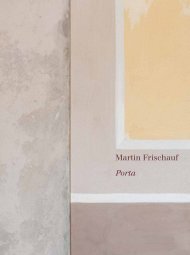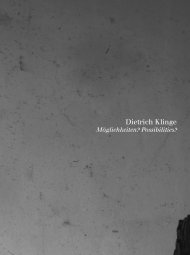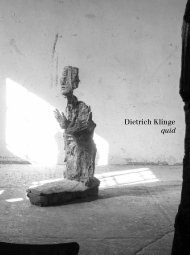Katalog_Portus_für_Jumpu
You also want an ePaper? Increase the reach of your titles
YUMPU automatically turns print PDFs into web optimized ePapers that Google loves.
Therein, it offers itself in closer proximity to the allegorical framework
of Courbet’s The Painter’s Studio. Initial understanding of the
canvas begins with the inclusion of the painter himself at the center
of the composition. He is surrounded, he is grounded. In the Portus,
the sculptor is likely to be physically absent but symbolically very
present. Certainly, it is a physical and measurable space but is even
more a conceptual space. Symbolically, both the physical and virtual
visitor must place themselves at the center of the composition,
as it were. Slowly surveying the space, one starts to feel the walls,
the light, the air, the objects. Touching is not required. Only feeling.
The presiding sentiment is solemnity.
With few exceptions, the majority of the sculptures on display are
decidedly frontal. Of these, most are fragmentary by recent design
or by virtue of their historical journey. They offer themselves as
physical and symbolic guardians. In their chapel hush, they never
confront but allow themselves to be examined, considered. Often,
they chorus: Egyptian, Classical, late 19th century life-size heads
in bronze and stone make a unified, regal statement. Smaller works
from Mesoamerica, Ancient Greece and Klinge meld under a generous
vitrine. They are less individual symbols as they are representations
of the concentrated power of the head as a living form and an
artistic touchstone. Klinge succeeds in a metaphorical presentation
of the human head as a secular holy grail. Time has collapsed, nobility
and knowledge has managed to survive, form is measurable
and intellect and spirit are immeasurable, only referenced.
98 99
Often Klinge has conducted duets. Among the most stirring is the
pairing of one of his recent sculptures with a late Egyptian, perhaps
Ptolemic period head. The torso form was initially created from a
decaying piece of wood carefully translated into iron whole the latter
is a granite fragment. The feline masculinity of the Klinge’s piece
presents a rare delicacy in his work and calls to mind the stylistic
achievements of the Ptolemic period. The relationship is neither
methodically planned not accidentally obtained, but somewhere in
the middle – a zone of historic conversation in which Klinge entered
long ago and, over time, became fluent. Another stirring, and more
volumetric pairing is the aforementioned head of a Roman dwarf
and a two part reclined and floating set of wooden figures Klinge
created early. Unlike so many stoic companions, they are tense in
movement and positioning. Extraordinarily, they are equals even
though they differ great in authorship, time, scale, and materials.
Such detailed examples considered, it is important to step back and
consider the installation at large. What message is offered, what
allegory? Foundationally, it reveals with sincerity a Contemporary
sculptor’s engagement with the history of art. The best of artists do
enter this vaulting conversation. But just as a foundation supports
a structure it also gives rise to walls and stories of a building. On
these walls and within these walls, there are stories as levels of existence,
survival, persistence. There is the reality of a timelessness
need to create. Therein, there is the timelessness and global need to
create specifically using the human form as a vessel and symbol. In
this there exists the head as a concentrated point of knowledge, discernment
and creativity. In contrast to many commonly accepted
conceptual frameworks, there is the head as physical gymnasium
and, perhaps repository for soulfulness. Where does sensation, feeling
and emotion go upon reflection and discernment? To the head.
Of course, entering the Portus is like entering the head of Dietrich
Klinge but it is never selfish and always generous in offering his
journey, his insights, up to the greater good of humanity.
As today’s present conditions leave many, perhaps most, feeling vulnerable,
connecting with the past offers community even if it cannot
offer physical strength. The realities of the moment crystallize our
fragilities and illuminate paths of isolation often avoided. Our psychology
today may be agitated, non-linear, even fearful. All seem to
long for another time before the current physical maladies and fiscal
















